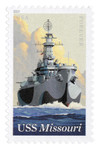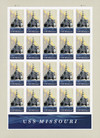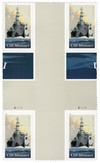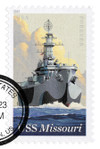
# 5392 - 2019 First-Class Forever Stamp - USS Missouri
US #5392
2019 USS Missouri
• Honors the United States’ last battleship, the same ship which hosted Japan’s surrender ceremony at the end of World War II – USS Missouri
Stamp Category: Commemorative
Value: 55¢ First Class Mail Rate (Forever)
First Day of Issue: June 11, 2019
First Day City: Honolulu, Hawaii
Quantity Issued: 20,000,000
Printed by: Banknote Corporation of America
Printing Method: Offset, Microprint
Format: Panes of 20
Tagging: Phosphor, Block Tag
Why the stamp was issued: To commemorate America’s last battleship the USS Missouri.
About the stamp design: Pictures a digital illustration of the USS Missouri by renowned stamp artist Dan Cosgrove.
First Day City: The First Day of Issue Ceremony was held at the Battleship Missouri Memorial at Pearl Harbor, Honululu, Hawaii.
History the stamp represents: On June 11, 1944, the USS Missouri (BB-63) was commissioned as America’s last battleship. In 2019, the USPS celebrated the “Mighty Mo” and its 75th anniversary with the issue of a new Forever stamp featuring an illustration by Dan Cosgrove. It pictures the Missouri as she appeared at her time of commission. The battleship served in several actions during her career including World War II, the Korean War, and Operation Desert Storm. The Missouri’s most famous role was hosting the official ceremony in which Japan surrendered to the Allies, ending World War II.
The USS Missouri was built at the Brooklyn Navy Yard from January 6, 1941, to January 29, 1944. She was the last of four Iowa-class ships commissioned by the US Navy. The ship was outfitted with nine 16-inch/50 caliber Mark 7 guns, twenty 5-inch/38 caliber guns in twin turrets, 49 Oerlikon 20 mm anti-aircraft guns, and 80 Bofors 40 mm anti-aircraft guns. The ship measured 887 feet, 3 inches long, could reach speeds up to 32.7 knots, and was crewed by 1,851 men.
As the last great American battleship, the USS Missouri represents the nostalgia of a bygone era. She was awarded three battle stars for actions in World War II, five for the Korean War, and three for the Gulf War. Today, the Missouri is a museum ship in Pearl Harbor, a fitting retirement for a lifetime of service defending her country.
US #5392
2019 USS Missouri
• Honors the United States’ last battleship, the same ship which hosted Japan’s surrender ceremony at the end of World War II – USS Missouri
Stamp Category: Commemorative
Value: 55¢ First Class Mail Rate (Forever)
First Day of Issue: June 11, 2019
First Day City: Honolulu, Hawaii
Quantity Issued: 20,000,000
Printed by: Banknote Corporation of America
Printing Method: Offset, Microprint
Format: Panes of 20
Tagging: Phosphor, Block Tag
Why the stamp was issued: To commemorate America’s last battleship the USS Missouri.
About the stamp design: Pictures a digital illustration of the USS Missouri by renowned stamp artist Dan Cosgrove.
First Day City: The First Day of Issue Ceremony was held at the Battleship Missouri Memorial at Pearl Harbor, Honululu, Hawaii.
History the stamp represents: On June 11, 1944, the USS Missouri (BB-63) was commissioned as America’s last battleship. In 2019, the USPS celebrated the “Mighty Mo” and its 75th anniversary with the issue of a new Forever stamp featuring an illustration by Dan Cosgrove. It pictures the Missouri as she appeared at her time of commission. The battleship served in several actions during her career including World War II, the Korean War, and Operation Desert Storm. The Missouri’s most famous role was hosting the official ceremony in which Japan surrendered to the Allies, ending World War II.
The USS Missouri was built at the Brooklyn Navy Yard from January 6, 1941, to January 29, 1944. She was the last of four Iowa-class ships commissioned by the US Navy. The ship was outfitted with nine 16-inch/50 caliber Mark 7 guns, twenty 5-inch/38 caliber guns in twin turrets, 49 Oerlikon 20 mm anti-aircraft guns, and 80 Bofors 40 mm anti-aircraft guns. The ship measured 887 feet, 3 inches long, could reach speeds up to 32.7 knots, and was crewed by 1,851 men.
As the last great American battleship, the USS Missouri represents the nostalgia of a bygone era. She was awarded three battle stars for actions in World War II, five for the Korean War, and three for the Gulf War. Today, the Missouri is a museum ship in Pearl Harbor, a fitting retirement for a lifetime of service defending her country.













